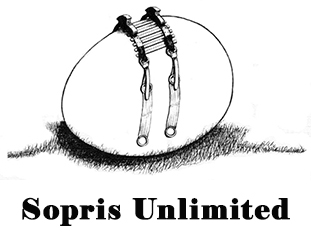Instructions for the Sopris Rookie Rigging
Cinches
Assuming your animal has been desensitized (see” Desensitizing Your Animal to the Pack” article) you are ready to begin. At a minimum he should be comfortable with you putting your hands on his back, chest, belly, and rear/flank area. If your animal kicks, lies down, or moves dramatically when you reach under to bring the cinches around, you may want to work with him a little more.
1. Brush to clear the wool of sticks and burrs that could irritate or sore the back or belly.
2. Your cinches are attached to the right side of the saddle to accommodate saddling from the left side. This will ensure that the rigging is consistently ready the next time you or someone else uses the saddle.
3. Before putting the saddle on, estimate the girth size and adjust the cinches accordingly (to limit the number of later adjustments) so that they will be centered on the animal’s belly when tightened. Estimate the distance on the Cinch Connecting Strap so that the rear cinch does not ride back too far into the penile area (for goats and alpacas the two cinches will almost be touching). This adjustment is easier done when the saddle is not on the animal.
4. Pull the cinches up and lay them across the top of the saddle. Then, set the saddle on the animal’s back, making sure it is not on backward. Aline the saddle so that the front cinch (cinch with Sopris logo tag) will come across the sternum with the front edge of the cinch approximately 1" behind the elbow.
5. Slowly lower the cinches so that they hang down on the opposite side from you. Holding onto the saddle with your left hand, reach under and take the cinch buckle with your right hand and connect it to saddle. Hold the saddle in place as you snug the front cinch. After your animal has gotten used to the saddling process and weight is added, the cinches must be tightened to the recommended tension. The front cinch must be tight. The rear cinch should just fit snugly against the belly. Pull and push your saddle from side to side and from front to rear. It will be difficult to move the saddle in any direction (except for the movement of the animal's skin along with the saddle) if you have cinched correctly.
6. Four Side Release Buckles (two on each cinch facing each other) are connections for the Pannier Stabilizing Straps which connect to the buckle toward the bottom center of each pannier (see “Sopris Panniers Instructions”). To disconnect side release buckle, squeeze at the sides. Leave these straps attached to the panniers rather than the cinches when not in use.
7. Walk your animal around to get him used to the cinches and saddle which shouldn’t take long.
8. Repeat the process until he is comfortable. You are ready for the chest strap and breeching.
Chest Strap and Breeching
Begin training with the chest strap and breeching completely disconnected from the saddle. Later, when you and your animal are familiar with the process you may choose to leave them attached to the saddle.
Chest Strap
The chest strap is used to ensure that the saddle does not move rearward when going up steep inclines. A chest strap is also recommended when packing in a string to keep the saddle from being stripped off the rear of your lead animal.
Placing the Chest Strap:
1. Insert the Chest Strap (logo tag) buckles to the front buckles on the saddle/ pad.
2. The chest strap should be centered on the chest and adjusted so that it is placed between the windpipe and the shoulder joint. Tighten the chest strap snugly when in use.
Breeching
The breeching is used to ensure that the saddle does not move forward while going down steep inclines.
Placing the Breeching:
1. Begin by standing on the left side of your animal
2. Connect the breeching buckles to the saddle buckles.
3. For a lama the perfect placement of the breeching is where the testicles used to be on a gelding. The top edge of the breeching should ride below the testicles on intact males and below the vulva of a female.
4. Tighten the breeching straps connected to the saddle when in use.
5. Walk your animal around to get him used to the breeching. He will dance and possibly kick a bit at first.
6. Repeat the process until he is comfortable with it.
7. Reverse the order when taking the saddle off. You are ready for the panniers.
